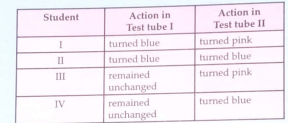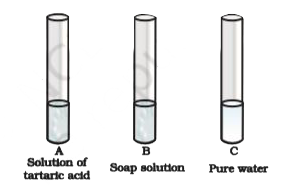2mL of ethanoic acid in each of the test tube I and II. A red litmus paper was intorduced in test tube 1 and a pH paper was introducd in test tube II. The experiment was performed by four students and they reported their observations is
 Solution in Punjabi
Solution in Punjabi
I
II
III
IV
Step by step video & image solution for 2mL of ethanoic acid in each of the test tube I and II. A red litmus paper was intorduced in test tube 1 and a pH paper was introducd in test tube II. The experiment was performed by four students and they reported their observations is by Chemistry experts to help you in doubts & scoring excellent marks in Class 10 exams.
Topper's Solved these Questions
- BOOK - MODERN PUBLICATIONCHAPTER - CARBON AND ITS COMPOUNDSEXERCISE - EXERCISE410videos
CARBON AND ITS COMPOUNDS
- BOOK - MODERN PUBLICATIONCHAPTER - ACID, BASES AND SALTSEXERCISE - EXERCISE433videos
ACID, BASES AND SALTS
- BOOK - MODERN PUBLICATIONCHAPTER - CHEMICAL REACTIONS AND EQUATIONSEXERCISE - EXERCISE141videos
CHEMICAL REACTIONS AND EQUATIONS
Similar Questions
Write the chemicla formula of the simplest hydrocarbon.
02:46View SolutionName the gas produced when
Sodium carbonate reacts with hydrochloric acid.01:45View SolutionTranslate the following statements into chemical equation and balance the equations : aluminium metal replaces iron from ferric oxide (Fe2O3) giving aluminium oxide and iron.
03:02View SolutionA student prepared hydrogen chloride gas by treating sodium chloride with concentrated sulphuric acid in a test tube. He held a strip of dry blue litmus paper in HCl gas coming out the test tube. The student observed that ton coming in contact with HCl gas, the colour of blue litmus paper:
02:44View SolutionThe test tube I contains sodium bicarbonate solution whereas test tube II contains lemon juice. On introducing pH paper strips in both the solutions, it is observed that the pH paper turns:
02:06View Solution2mL of ethanoic acid was taken in each of test tube I and test tube II. A red litmus paper was introduced in test tube I and a pH paper was introduced in test tube II. The experiment was performed by four students A,B,C and D and they reported their observations as given below: The correct set of observations was made by the student:
View SolutionYou are provided with three test tubes containing distilled water, an acid and a base solution respectively. If you are given only blue litmus paper, how do you identify the contents of each test tube ?
05:10View Solutionఒక ప్రయోగంలో పరీక్షనాళికని ద్రావణంలో నీలీలిట్మస్ పేపరు ముంచగా అది ఎరుపురంగులోకి మారినది. అది ఆ ద్రావణం pH విలువ
02:19View SolutionSodium chloride was taken in a test tube and conc. H2SO4 acid added to it and the gas was tested with a moist litmus paper. Give your observation.
01:56View Solution(i) You have three unlabelled test-tubes containing ethanol, ethanoic acid and soap solution. Explain the method you would use to identify the compounds in different test tubes by chemical tests using litmus paper and sodium metal. (ii) Give the reason of formation of scum when soaps are used with hard water.
View Solutionनौसादर को एक परखनली में गर्म करने पर परखनली के मुँह पर रखा लाल लिटमस कागज पहले नीला फिर लाल हो जाता है क्योंकि
01:12View Solutionनौसादर को एक परखनली में गर्म करने पर परखनली के मुँह पर लाल लिटमस कागज पहले नीला फिर लाल हो जाता है क्योंकि
02:55View Solutionनौसादर को एक परखनली में गर्म करने पर परखनली के मुँह पर लाल लिटमस कागज़ पहले नीला फिर लाल हो जाता है क्योंकि
02:38View SolutionTest tube 'P' contain NaHCO_3 solution. Test tube 'Q' contain lemon juice. On introducing pH paper strips on both of them it is observed that the pH paper turns.
04:13View SolutionYou are provided with three test tubes A,B and C as shown in Figure 5.3 with different liquids . What will you observe when you put
(a) a piece of blue litmus paper in each test tube .
(b) a piece of red litmus paper in each test tube .
(c ) a few drops of phenolphthalein solution to each test tube .
 View Solution
View SolutionA student performed the first set of experiments with four test tubes containing solutions and metal pieces as indicated in the figure. In the second set of experiments, the metal pieces are interchanged between test tubes P and Q and also between test tubes R and S. In which test tube(s), no reaction will occur in both sets of experiments ?
02:05View Solution

